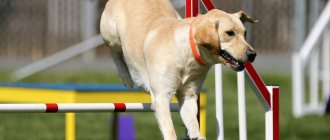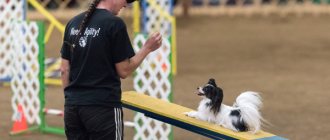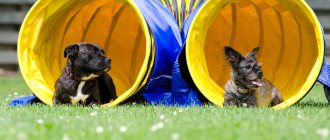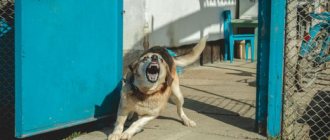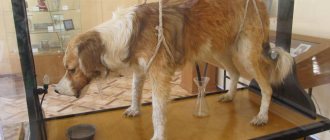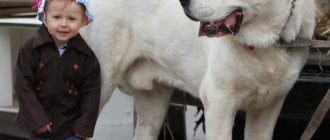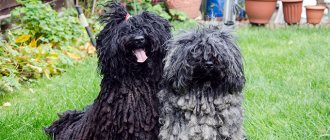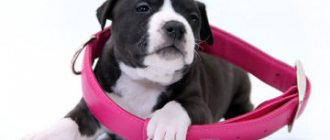The popularity of cynological courses is explained by the unique opportunity to raise a pet adapted to city life. In addition to basic disciplines, instructors tell you how to teach a dog agility. Unlike OKD, UGS and ZKS, this active discipline is aimed at developing and maintaining physical fitness, which is especially important for pets who are deprived of the opportunity to walk freely - that is, living in an apartment.
What is agility
What epithets come to mind when we think about dogs - agile, fast, jumping. Agility is a sport in which all these qualities of a dog are revealed more than anywhere else. The word “agility” is translated from English - speed, dexterity.
Agility competitions involve the participation of not only the dog itself, but also the owner or his representative. The person performing with the dog is called the handler. He guides the animal on the obstacle course, helps with commands, and corrects behavior.
The competition itself takes place in the form of an obstacle course. This is another plus for the popularity of agility, because such competitions are quite easy to organize. Typically obstacle courses should be 200 meters long. Obstacles are located on them every 10 meters.
The strip may not be straight, but in any form that the organizers come up with. This loading of obstacles allows not only the handler and his ward, but also the spectators, of whom there are many, to enjoy the process.
History of appearance
Since its inception, agility has been simply entertainment for spectators. At one of the dog shows in Great Britain, one of the organizers, John Varley, made an attempt to entertain the spectators. He wanted to show something that no one had offered before that moment. He was assisted by his friend Peter Meanwell.
Since both were fond of equestrian sports, it occurred to them to take the obstacle course as a basis from there. Some elements and obstacles were copied. Something was invented additionally, specifically for the dog.
In 1978, at an exhibition, friends first presented such entertainment to the attention of viewers. Everyone was delighted. Such competitions were repeated the next year, at another exhibition.
After a short amount of time, agility was officially recognized as one of the sports.
In Russia, the first agility championship was held in 1994. The number of participants for our huge country was very small - only 12 couples. The following year, the Russian Cup was held, the importance of the competition was emphasized by the fact that Jean Paul Petididier, the chairman of agility in the FCI sports committee, acted as the chief judge. Since 1996, Russian teams have been regular participants in the World Agility Championships.
Dogs participants
Another advantage of agility is its complete openness to dogs of all breeds. It would be more accurate to say that outbred dogs can also take part. There are no admissions in the form of pedigree or other evidence of the breed.
But restrictions still exist, although they are advisory in nature:
- age. In agility competitions, it is better to enter an animal over a year old. The skeleton of such animals and their psyche have been formed. This will help protect you from injury on the obstacle course. It is better not to bring your puppy to competitions;
- pregnancy. Pregnant bitches are not allowed to participate;
- training. Dogs must be able to comply with the handler's demands, know basic commands and be able to overcome obstacles.
Although the breed does not matter, it has been observed from experience that agility is best suited for herding breed dogs.
For convenience and for equality of tailed participants, they are divided into categories:
- “S” - small - less than 35 cm at the withers;
- “M” - medium - 35-43 cm at the withers;
- “L” – large – from 43 cm at the withers.
The competition begins with participants from the S category, then the other two in succession. This happens because some equipment on the obstacle course are adjusted specifically to the height of the participant. For example, the height of the barrier.
Based on the experience of holding competitions, certain dog breeds have already emerged that most often become winners in their categories. In the “small” category, the most successful dogs are the Spitz breed, in the “medium” Sheltie, and in the “large” category – the Border Collie. Border collies are very fast dogs. Many breeders use a trick and breed a Border Collie dog with a height that allows it to compete in overcoming obstacles in the smallest category, where it is among the leaders.
Rules
The main rules of agility include:
- dogs of any breed, age, gender and body structure are allowed to participate in competitions (in addition to certification);
- The handler can “guide” the pet only by voice commands, postures or gestures. Rewards in the form of treats, teasing toys or touching are prohibited;
- The route and numbering of obstacles is selected individually for each selection of participants. The lane is designed so that the dog cannot pass it on his own;
- the route is passed only once. Based on the passage, the dog earns points;
- the conductor can go through the route himself once in order to choose the optimal tactics and minimize the time it takes to pass the strip;
- for hitting a pet - disqualification.
While running the favorites of the track, he is awarded points or penalties (for example, for refusing to overcome a barrier, etc.).
What shells are used
The International Canine Association has established the types of equipment that are used in agility. The main requirement is safety for the pet. The organizers themselves can mix them on the obstacle course in any order. It is allowed to install obstacles in any way.
All projectiles are divided into two groups:
- Assume contact with the participant;
- Does not involve contact.
Contact
- "Slide". Two planes connected in the form of an inverted “V”, the highest point is at a height of 1.5-2 meters from the ground. Wooden strips parallel to each other are attached to them, providing an anti-slip effect. The handler gives the command: “Home”, “Slide”.
- "Swing". Similar to a children's swing, on which two people ride, located at different ends. At the moment when the pet begins to move along the projectile, one of the sides moves down and the handler gives the command to move: “Swing”;
- "Boom". Unusual slide. The difference is that the shields are not connected at an angle. And between them there is a wide board along which the pet must run. In some ways the apparatus resembles a gymnastic beam. They give the command: “Boom”;
- "Tunnel". The obstacle looks like a wide pipe. The tunnel can be soft or hard. Positioned differently on the obstacle course. They give the command: “Tun” or “Bottom.”
Contactless
- "Barrier". The projectile is designed according to the principle used by track and field athletes. Two supports with a transverse bar, which is knocked down if necessary, so as not to injure the animal in the process of overcoming obstacles. The dog must pass the barrier without knocking down the bars. Command: “Jump”, “Up”, “Hop”;
- "Ring". The point of overcoming the projectile is for the dog to jump through a ring fixed to the posts. Team: “Circle”, “Tire”, “Bar”.
- "Bounce". Jumps must be performed by the dog on command, over several obstacles at once. Command: “Hop”, “Jump”, “Up”;
- "Slalom". The animal must run around twelve obstacles in the form of racks located strictly along the line. The passage is a snake. Command: "Trrr";
- "Podium-square". A square-shaped area located at a height specified for different categories, from 2 to 75 cm. The dog must jump onto this square and fixate there for a certain time: “Hop”.
Regulations
There are no clear and strict rules for agility. The evaluation criteria are also not clearly defined.
There are a number of restrictions:
- The dog should not be wearing a leash or collar while overcoming obstacles;
- the handler cannot use any means of encouragement;
- Contact between the handler and the dog on the strip must be excluded.
You cannot help your pet overcome an obstacle. Before the competition, the handler can inspect the stripes, understand where and how the obstacles are located, think through the passage, and calculate the strength of the pet.
There are two criteria for assessing exercise performance:
- cleanliness of obstacle passage;
- time.
It cannot be said that any of them is decisive. However, the cleanliness of performing exercises on the band is still more important than time.
Penalty points are awarded if:
- the dog did not meet the allotted time;
- the pet went through the wrong gate;
- contact between the handler and the dog or obstacle;
- the pet refused to work.
Fines are also imposed on the handler for negative behavior: cruelty to the pet, rudeness towards the judge.
Ultimately, the winner will be the dog that runs the entire course with the optimal cleanliness-time ratio.
Photo
Sources
- https://kinpet.ru/adzhiliti-dlya-sobak-vid-sporta-dlya-aktivnykh-chetveronogikh-/
- https://dogtricks.ru/sport/adzhiliti
- https://VetManol.ru/obuchenie-i-vospitanie/adzhiliti-dlya-sobak-chto-eto-2.html
- https://PetGuru.ru/dressirovka/adzhiliti-dlya-sobak
- https://moypitomec.ru/sobaki/vospitanie-i-dresirovka/adzhiliti-dlja-sobak.html
- https://sobakagav.ru/chto-takoe-adzhiliti-pravila-snaryady-i-porody-sobak-dlya-adzhiliti/
- https://dogworry.ru/dressirovka/adzhiliti-dlya-sobak-chto-eto-takoe.html
- https://porodadog.ru/vospitanie/dressirovka/adzhiliti.html
[collapse]
We recommend reading:
- An enclosure for a dog: how to make a beautiful warm outdoor enclosure with a winter road with your own hands - drawings, sizes, photos, projects, tips on how to build it yourself
- DIY dog house, design of a beautiful large dog house with a veranda, kennel in the apartment
- Caring for a dog's fur: how and what to comb properly, combs for long, short-haired, smooth-haired dogs, how to comb tangles, products - shampoo, spray
- Knitted clothes for small dogs - knitting patterns
Competition levels
During the obstacle course competition, the dog must receive an “Agility Certificate.” It is issued if there are three “Excellent” ratings at the first stage.
Further, the dog’s level of participation depends on previous achievements:
- Agility 1 and Jumping 1. Participants: those who are new and those who have not yet received a Certificate;
- Agility 2 and Jumping 2 Participants: those who already have a Certificate;
- Agility 3 and Jumping 3. Participants: those who have prizes for victories at previous levels and in Jumping 2, at least three.
Definition of control time (CT)
The main factor in determining the EF of the course is the speed (m/s) at which participants must cover the distance. In this case, the class of competition and the complexity of the distance are taken into account.
The movement speed is set within 1.8-3.5 m/s.
The control time in seconds is obtained by dividing the exact length of the distance by the set speed. For example: distance length is 150 m, selected speed is 2.5 m/s. KB is defined as 150:2.5=60 seconds.
How to train
An indispensable condition for a successful performance is the dog’s ability to follow commands and overcome obstacles, close contact and mutual understanding with the handler.
Classes to prepare for competitions can be conducted at home, on sites near the house, or in nature. You can make simulators so that your pet has an idea of the obstacle course that will have to be overcome.
But, of course, the best option would be training on the basis of a kennel club. There the conditions are as close as possible to competitive ones. The obstacle course in such schools and clubs completely replicates the professional ones. The pet will get used to following commands surrounded by other animals and going through trails. That is, he will gain some competitive experience. And the handler himself will gain experience of participation and understand how to correctly overcome obstacles.
The only disadvantage of classes at the club is the cost. Training lasts on average 3 hours, 1-2 times a week. The cost is usually no more than 500 rubles per lesson.
Preparation tips:
- interest your pet, training should take place in the form of a game, but with unobtrusive control;
- Offer your pet a variety of exercises to overcome obstacles. Don’t turn exercise into a routine; even the most persistent lover of running will soon get tired of the monotony;
- Never show annoyance or punish your pet for incorrectly following commands.
Briefly about the main thing
- Agility is a sport for the dog and the owner;
- The sport originated in England in 1978, Russia has been a participant in international competitions since 1996;
- A pet of any breed or a completely mongrel can become a participant;
- There are dog breeds that are more successful in this sport;
- Agility has three levels of difficulty, depending on whether the dog has a Certificate;
- You need to prepare your puppy gradually and better in a kennel club;
- There are three difficulty levels in the competition;
Breeds
Every dog will be glad to know what agility is. Any breed of dog, and even mongrel dogs, can take part in the competition. Absolutely any dog can win a prize, because the main thing is a good connection between the owner and the pet, which allows them to work harmoniously as a team.
Dogs with substantial dimensions (Great Danes, Wolfhounds, Leonbergers) may have problems passing some obstacles, for example, it may be difficult for them to squeeze into a tunnel. It will also be more difficult for dogs whose shoulder and hip joints are located at right angles. For this reason, terriers and schnauzers will perform slightly worse in slalom and hurdles, but dogs with a creeping gait, such as shepherd dogs, will have an advantage in these apparatuses.
Nevertheless, absolutely everyone can do agility. After all, cups and victories are not the main thing. First of all, agility training is a great chance to improve your relationship with your pet, strengthen the owner-dog bond and just have fun with your four-legged friend. In addition, it is no secret that a dog must constantly develop. Agility training can be both good physical exercise and food for the mind.
